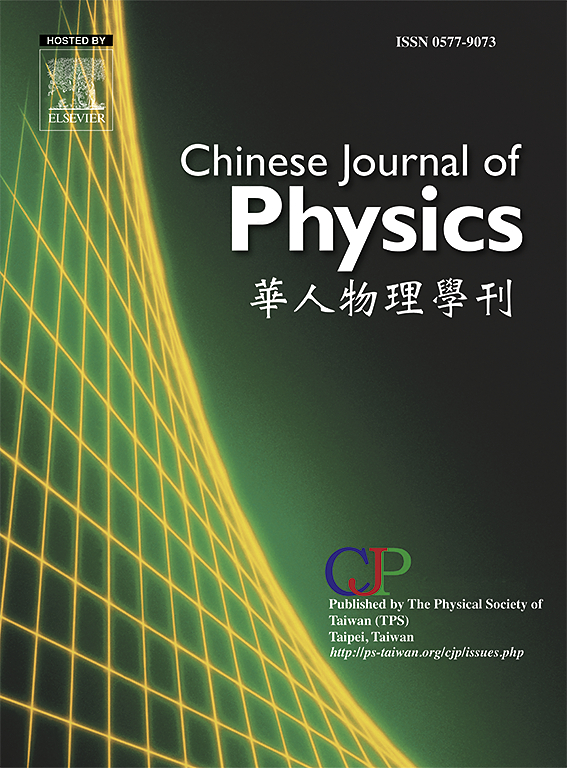Non-singular bouncing cosmology in f(T,T) gravity with energy condition violations
IF 4.6
2区 物理与天体物理
Q1 PHYSICS, MULTIDISCIPLINARY
引用次数: 0
Abstract
The singularity and inflationary problems have posed significant challenges for understanding the universe’s origin and evolution. Bouncing cosmology has emerged as a promising alternative to standard cosmological models, offering a non-singular approach to early universe dynamics by facilitating a ”bounce” rather than a singular beginning. In this study, we explore the feasibility of modeling specific bouncing scenarios within the framework of gravity, allowing for a comprehensive coupling between the torsion scalar and the trace of the energy–momentum tensor . We analyze two models: a linear model and a non-linear model , with a parameterized scale factor to capture the bounce behavior. The analysis confirms a cosmic bounce at , where the Hubble parameter signals a transition from contraction to expansion. A crucial condition for achieving the bounce is the violation of the null energy condition (NEC) near the bounce, enabling the equation of state (EoS) parameter to enter the phantom region (). Both models exhibit an increase in energy density as the universe approaches the bounce, peaking at the bounce epoch and then decreasing post-bounce. Pressure remains negative throughout, with the EoS parameter crossing into the phantom region near the bounce in both positive and negative time zones. Our findings show that NEC and strong energy condition (SEC) violations are essential for the non-singular bounce, while the dominant energy condition (DEC) is satisfied, ensuring a consistent matter distribution. These results indicate that both linear and non-linear models effectively replicate the critical features of a bouncing cosmology, offering valuable approaches for addressing the singularity and inflationary challenges in cosmology.

具有能量条件违反的f(T,T)重力中的非奇异弹跳宇宙学
奇点和暴胀问题对理解宇宙的起源和演化提出了重大挑战。弹跳宇宙学已经成为标准宇宙学模型的一个有希望的替代方案,通过促进“弹跳”而不是单一的开始,为早期宇宙动力学提供了一种非奇异的方法。在本研究中,我们探索了在f(T,T)重力框架内建模特定弹跳场景的可行性,允许扭转标量T与能量动量张量T的轨迹之间的全面耦合。我们分析了两个f(T,T)模型:线性模型f(T,T)=αT+βT和非线性模型f(T,T)=α−T+βT,参数化尺度因子a(T)= a02+γ2t2来捕获弹跳行为。分析证实了宇宙在t=0时的反弹,此时哈勃参数H=0标志着从收缩到膨胀的转变。实现弹跳的一个关键条件是在弹跳附近违反零能量条件(NEC),使状态方程(EoS)参数进入虚区(ω<−1)。当宇宙接近弹跳时,两种模型都表现出能量密度的增加,在弹跳时期达到峰值,然后在弹跳之后下降。压力始终保持为负,EoS参数在正时区和负时区的反弹附近进入幻区。我们的研究结果表明,非奇异弹跳必须满足NEC和强能量条件(SEC),同时满足主导能量条件(DEC),从而保证了物质分布的一致性。这些结果表明,线性和非线性f(T,T)模型都有效地复制了弹跳宇宙学的关键特征,为解决宇宙学中的奇点和暴胀挑战提供了有价值的方法。
本文章由计算机程序翻译,如有差异,请以英文原文为准。
求助全文
约1分钟内获得全文
求助全文
来源期刊

Chinese Journal of Physics
物理-物理:综合
CiteScore
8.50
自引率
10.00%
发文量
361
审稿时长
44 days
期刊介绍:
The Chinese Journal of Physics publishes important advances in various branches in physics, including statistical and biophysical physics, condensed matter physics, atomic/molecular physics, optics, particle physics and nuclear physics.
The editors welcome manuscripts on:
-General Physics: Statistical and Quantum Mechanics, etc.-
Gravitation and Astrophysics-
Elementary Particles and Fields-
Nuclear Physics-
Atomic, Molecular, and Optical Physics-
Quantum Information and Quantum Computation-
Fluid Dynamics, Nonlinear Dynamics, Chaos, and Complex Networks-
Plasma and Beam Physics-
Condensed Matter: Structure, etc.-
Condensed Matter: Electronic Properties, etc.-
Polymer, Soft Matter, Biological, and Interdisciplinary Physics.
CJP publishes regular research papers, feature articles and review papers.
 求助内容:
求助内容: 应助结果提醒方式:
应助结果提醒方式:


